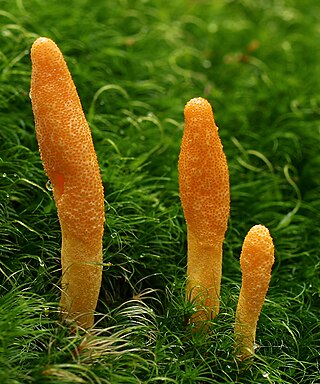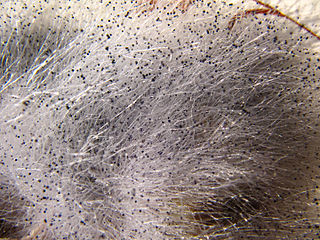Genus is a taxonomic rank used in the biological classification of living and fossil organisms as well as viruses. In the hierarchy of biological classification, genus comes above species and below family. In binomial nomenclature, the genus name forms the first part of the binomial species name for each species within the genus.

Bombax is a genus of mainly tropical trees in the mallow family. They are native to western Africa, the Indian subcontinent, Southeast Asia, and the subtropical regions of East Asia and northern Australia. It is distinguished from the genus Ceiba, which has whiter flowers.

Beauveria bassiana is a fungus that grows naturally in soils throughout the world and acts as a parasite on various arthropod species, causing white muscardine disease; it thus belongs to the entomopathogenic fungi. It is used as a biological insecticide to control a number of pests, including termites, thrips, whiteflies, aphids and various beetles. Its use in the control of bedbugs and malaria-transmitting mosquitos is under investigation.

Beauveria is a genus of asexually-reproducing fungi allied with the ascomycete family Cordycipitaceae. Its several species are typically insect pathogens. The sexual states (teleomorphs) of Beauveria species, where known, are species of Cordyceps.

Curculio nucum, the nut weevil, is a medium-sized beetle, with an especially elongated snout, characteristic of the Curculionini tribe of the weevil family (Curculionidae). Its larvae develop in hazel nuts Corylus avellana, being a serious pest in hazelnut orchards. It occurs in most of Europe, from south Sweden, Finland and Great Britain to the Mediterranean.

Jean Paul Vuillemin was a French mycologist born in Docelles.

Lichtheimia corymbifera is a thermophilic fungus in the phylum Zygomycota. It normally lives as a saprotrophic mold, but can also be an opportunistic pathogen known to cause pulmonary, CNS, rhinocerebral, or cutaneous infections in animals and humans with impaired immunity.

The Jena Microbial Resource Collection (JMRC) is a joint collection of the Leibniz Institute for Natural Product Research and Infection Biology – Hans-Knöll-Institute and the University of Jena. It was founded in October 2010 by merging two earlier collections from the two above-mentioned institutes. It is a research institution, which is not normally open to the public. With about 15,000 fungal and about 35,000 bacterial living isolates, it is the largest collection of this kind in Germany. The microorganisms are maintained as active cultures, with some of them in cryopreservation.

The Cordycipitaceae are a family of parasitic fungi in the Ascomycota, class Sordariomycetes and order Hypocreales. The family was first published in 1969 by mycologist Hanns Kreisel, but the naming was invalid according to the code of International Code of Nomenclature for algae, fungi, and plants. It was validly published in 2007.
Neofusicoccum pennatisporum is an endophytic fungus that might be a canker pathogen, specifically for Eucalyptus gomphocephala. It was isolated from said trees in Western Australia.
Aplosporella yalgorensis is an endophytic fungus that might be a canker pathogen, specifically for Eucalyptus gomphocephala. It was isolated from said trees in Western Australia.

Rhizopus stolonifer is commonly known as black bread mold. It is a member of Zygomycota and considered the most important species in the genus Rhizopus. It is one of the most common fungi in the world and has a global distribution although it is most commonly found in tropical and subtropical regions. It is a common agent of decomposition of stored foods. Like other members of the genus Rhizopus, R. stolonifer grows rapidly, mostly in indoor environments.
Erynia is a genus of fungi within the family of Entomophthoraceae and order Entomophthorales of the Zygomycota. This has been supported by molecular phylogenetic analysis.
Lichtheimiaceae is a family of fungi in the order Mucorales. The family was circumscribed in 2013 after a molecular phylogenetic analysis helped delineate a new family structure for the Mucorales.
Dothistroma is a genus of fungi belonging to the family Mycosphaerellaceae.

Furia is a genus of fungi within the family of Entomophthoraceae of the Zygomycota. This has been supported by molecular phylogenetic analysis.
Lichtheimia ramosa is a saprotrophic zygomycete, typically found in soil or dead plant material. It is a thermotolerant fungus that has also been known to act as an opportunistic pathogen–infecting both humans and animals.









